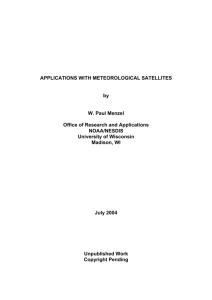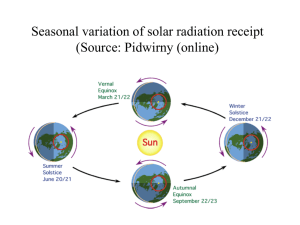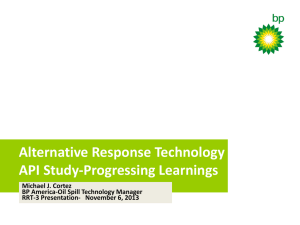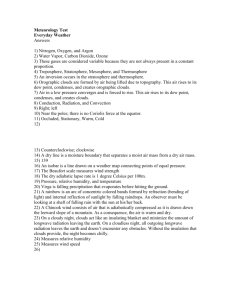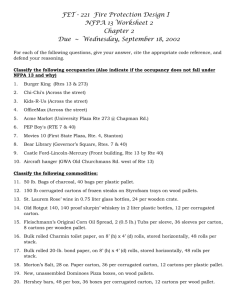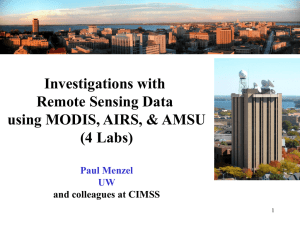NOTES ON SATELLITE METEOROLOGY
advertisement
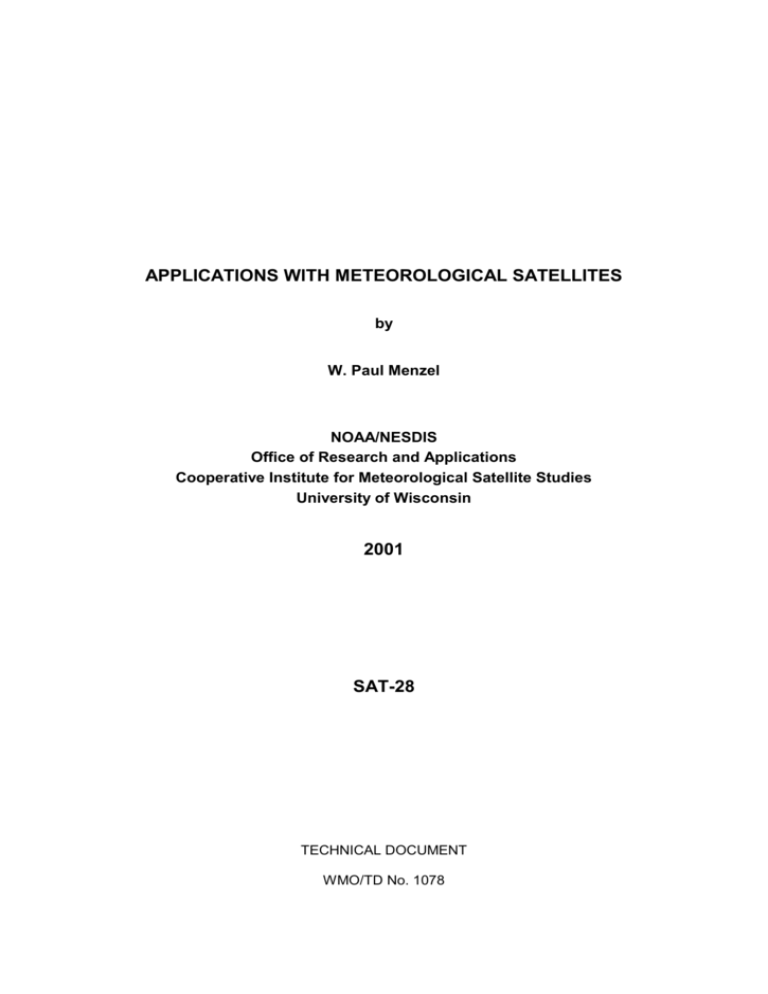
APPLICATIONS WITH METEOROLOGICAL SATELLITES by W. Paul Menzel NOAA/NESDIS Office of Research and Applications Cooperative Institute for Meteorological Satellite Studies University of Wisconsin 2001 SAT-28 TECHNICAL DOCUMENT WMO/TD No. 1078 -iTABLE OF CONTENTS Page CHAPTER 1 1.1 1.2 1.3 1.4 1.5 Before satellites ............................................................................................................. 1-1 Evolution of the Polar Orbiting ....................................................................................... 1-1 The Geostationary Programme ...................................................................................... 1-6 Data Processing Capability ............................................................................................ 1-9 Summary...................................................................................................................... 1-10 CHAPTER 2 2.1 2.2 2.3 2.4 2.5 2.5.1 2.5.2 2.5.3 2.5.4 2.5.5 - ABSORPTION, EMISSION, REFLECTION, AND SCATTERING Absorption and Emission................................................................................................ 3-1 Conservation of Energy .................................................................................................. 3-1 Planetary Albedo ............................................................................................................ 3-2 Selective Absorption and Emission ................................................................................ 3-2 Absorption /Emission) Line Formation ............................................................................ 3-4 Vibrational and Rotational Spectra ................................................................................. 3-5 Summary of the Interaction between Radiation and Matter ............................................ 3-7 Beer’s Law and Schwarzchild’s Equation ....................................................................... 3-7 Atmospheric Scattering ................................................................................................ 3-10 Solar Spectrum ............................................................................................................ 3-11 Composition of the Earth’s Atmosphere ....................................................................... 3-11 Atmospheric Absorption and Emission of the Solar Radiation ...................................... 3-12 Atmospheric Absorption and Emission of thermal Radiation ........................................ 3-12 Atmospheric Absorption Bands in the Infrared Spectrum ............................................. 3-13 Atmospheric Absorption Bands in the Microwave Spectrum ......................................... 3-14 Remote Sensing Regions............................................................................................. 3-14 CHAPTER 4 4.1 4.2 4.3 4.4 4.5 4.6 - NATURE OF RADIATION Remote Sensing of Radiation ......................................................................................... 2-1 Basic Units ..................................................................................................................... 2-1 Definitions of Radiation .................................................................................................. 2-2 Historical Development of Planck’s Radiation Law ......................................................... 2-3 Related Derivations ........................................................................................................ 2-6 Wien’s Displacement Law .............................................................................................. 2-6 Rayleigh-Jeans Radiation Law ....................................................................................... 2-7 Wien’s Radiation Law..................................................................................................... 2-7 Stefan-Boltzmann Law ................................................................................................... 2-8 Brightness Temperature ................................................................................................. 2-8 CHAPTER 3 3.1 3.2 3.3 3.4 3.5 3.6 3.7 3.8 3.9 3.10 3.11 3.12 3.13 3.14 3.15 3.16 - EVOLUTION OF SATELLITE METEOROLOGY - THE RADIATION BUDGET The Mean Global Energy Balance .................................................................................. 4-1 The First Satellite Experiment to Measure the Net Radiation ......................................... 4-1 The Radiation Budget .................................................................................................... 4-2 Distribution of Solar Energy Intercepted by the Earth ..................................................... 4-4 Solar Heating Rates ....................................................................................................... 4-4 Infrared Cooling Rates ................................................................................................... 4-5 - ii 4.7 Radiative Equilibrium in a Gray Atmosphere .................................................................. 4-5 CHAPTER 5 5.1 5.2 5.3 5.4 5.5 5.6 5.6.1 5.6.2 5.6.3 5.6.4 5.6.5 5.7 5.7.1 5.7.2 5.7.3 5.7.4 5.7.5 5.8 5.8.1 5.8.2 5.9 5.10 Derivation of RTE ........................................................................................................... 5-1 Temperature Profile Inversion ........................................................................................ 5-4 Transmittance Determinations ....................................................................................... 5-5 Fredholm Form of RTE and the Direct Linear Inversion method .................................... 5-6 Linearization of the RTE ................................................................................................. 5-8 Statistical Solutions for the Inversion of the RTE ............................................................ 5-8 Statistical Least Squares for the Inversion of the RTE ................................................... 5-8 Constrained Linear Inversion of the RTE........................................................................ 5-9 Statistical Regularization .............................................................................................. 5-10 Minimum Information Solution ..................................................................................... 5-11 Empirical Orthogonal Functions ................................................................................... 5-12 Numerical Solutions for the Inversion of the RTE ......................................................... 5-16 Numerical Iteration Solution ......................................................................................... 5-16 Example Problem using the Chahine Relaxation Method ............................................. 5-18 Smith’s Numerical Iteration Solution ............................................................................. 5-20 Example problem using Smith’s iteration...................................................................... 5-21 Comparison of the Chahine and Smith Numerical Iteration Solution ............................ 5-23 Direct Physical Solution ................................................................................................ 5-23 Example Problem Solving Linear RTE Directly ............................................................. 5-23 Simultaneous Direct Physical Solution of the RTE for Temperature and Moisture ....... 5-25 Water Vapour Profile Solutions .................................................................................... 5-27 Microwave Form of RTE............................................................................................... 5-29 CHAPTER 6 6.1 6.2 6.3 6.3.1 6.3.2 6.4 6.4.1 6.4.2 6.4.3 6.4.4 6.4.5 6.4.6 6.4.7 6.5 6.5.1 6.5.2 6.5.3 - CLOUDS RTE in Cloudy Conditions .............................................................................................. 6-1 Inferring Clear Sky Radiances in Cloudy Conditions ...................................................... 6-2 Finding Clouds ............................................................................................................... 6-3 Threshold and Difference Tests to Find Clouds ............................................................. 6-4 Spatial Uniformity Tests to Find Cloud ........................................................................... 6-9 The Cloud Mask Algorithm ........................................................................................... 6-10 Thick High Clouds (Group 1 Tests) .............................................................................. 6-11 Thin Clouds (Group 2 Tests) ........................................................................................ 6-11 Low Clouds (Group 3 Tests) ........................................................................................ 6-11 High Thin Clouds (Group 4 Tests) ................................................................................ 6-12 Ancillary Data Requirements ....................................................................................... 6-12 Implementation of the Cloud Mask Algorithms ............................................................. 6-13 Short-term and Long-term Clear Sky Radiance Composite Maps ................................ 6-13 Ongoing Climatologies ................................................................................................. 6-14 ISCCP ....................................................................................................................... 6-14 CLAVR ....................................................................................................................... 6-15 CO2 slicing ................................................................................................................... 6-15 CHAPTER 7 7.1 7.1.1 - THE RADIATIVE TRANSFER EQUATION (RTE) - SURFACE TEMPERATURE Sea Surface Temperature Determination ....................................................................... 7-1 Slope Method ................................................................................................................. 7-1 - iii 7.1.2 7.1.3 7.2 7.3 7.4 Three Point Method ........................................................................................................ 7-2 Least Squares Method ................................................................................................... 7-2 Water Vapour Correction for SST Determinations.......................................................... 7-3 Accounting for Surface Emissivity in the Determination of SST ...................................... 7-6 Estimating Fire Size and Temperature ........................................................................... 7-7 CHAPTER 8 8.1 8.1.1 8.1.2 8.1.3 8.1.4 8.2 8.2.1 8.2.2 8.2.3 8.3 8.4 8.5 8.6 Total Water Vapour Estimation ...................................................................................... 8-1 Split Window Method ..................................................................................................... 8-1 Split Window Variance Ratio .......................................................................................... 8-1 Perturbation of Split Window RTE .................................................................................. 8-3 Microwave Split Window Estimation of Atmospheric Water Vapour and Liquid Water ... 8-3 Total Ozone Determination ............................................................................................ 8-4 Total Ozone from Numerical Iteration............................................................................. 8-4 Physical Retrieval of Total Ozone .................................................................................. 8-5 HIRS Operational Algorithm ........................................................................................... 8-7 Determination of Cloud Height and Effective Emissivity ................................................. 8-8 Geopotential Height Determination .............................................................................. 8-10 Microwave Estimation of Tropical Cyclone Intensity ..................................................... 8-11 Satellite Measure of Atmosphere Stability .................................................................... 8-13 CHAPTER 9 9.1 9.2 9.3 9.4 9.5 9.5.1 - TECHNIQUES FOR DETERMINING ATMOSPHERIC PARAMETERS - TECHNIQUES FOR DETERMINING ATMOSPHERIC MOTIONS Atmospheric Motion ....................................................................................................... 9-1 Geostrophic Winds ......................................................................................................... 9-1 Gradient Winds .............................................................................................................. 9-3 Thermal Winds ............................................................................................................... 9-4 Inferring Winds from Cloud Tracking .............................................................................. 9-4 Current Operational Procedures..................................................................................... 9-5 CHAPTER 10 - APPLICATIONS OF GEOSTATIONARY SATELLITE SOUNDING DATA 10.1 10.2 10.3 Detection of Temporal and Spatial Gradients ............................................................... 10-1 VAS Detection of rapid Atmospheric Destabilization .................................................... 10-1 Operational GOES Sounding Applications ................................................................... 10-3 CHAPTER 11 - SATELLITE ORBITS 11.1 11.2 11.3 11.4 11.5 Orbital Mechanics ........................................................................................................ 11-1 The Geostationary Orbit ............................................................................................... 11-1 Orbital Elements........................................................................................................... 11-1 Gravitational Attraction of Non-spherical Earth ............................................................. 11-3 Sun synchronous Polar Orbit ....................................................................................... 11-4 CHAPTER 12 - RADIOMETER DESIGN CONSIDERATIONS 12.1 12.2 12.3 12.3.1 Components and Performance Characteristics ............................................................ 12-1 Spectral Separation ...................................................................................................... 12-1 Design Considerations ................................................................................................. 12-1 Diffraction ..................................................................................................................... 12-1 - iv 12.3.2 12.3.3 12.3.4 12.3.5 The Impulse or Step Response Function ..................................................................... 12-2 Detector Signal to Noise............................................................................................... 12-2 Infrared Calibration....................................................................................................... 12-3 Bit Depth ...................................................................................................................... 12-5 APPENDICES A. EIGENVALUE PROBLEMS B. REFERENCES C. PROBLEMS D. EXAM
